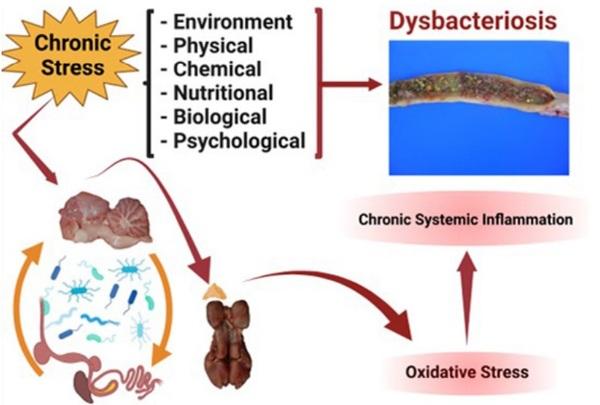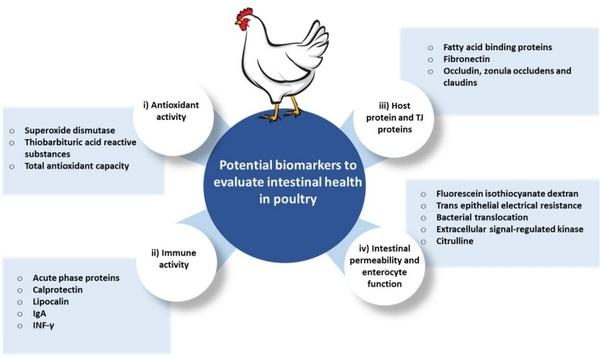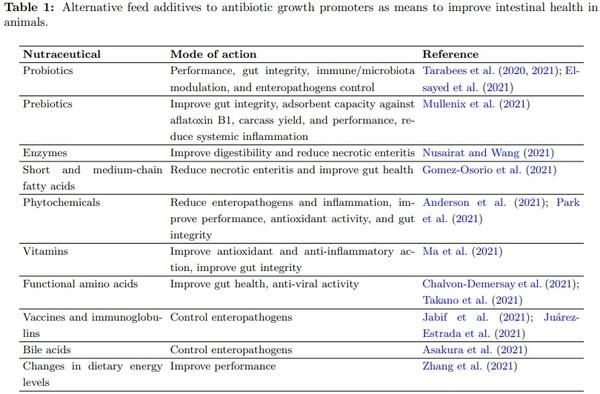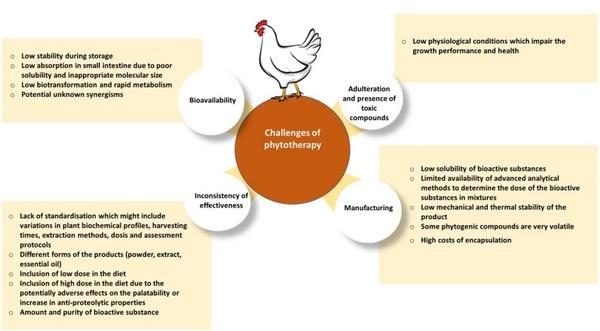Restoring healthy gut microbiome in poultry using alternative feed additives with particular attention to phytogenic substances: Challenges and prospects
Author details:





Ahmar, S., Gill, R.A., Jung, K.H., Faheem, A., Qasim, M.U.,
Mubeen, M., Zhou, W., 2020. Conventional and molecular techniques from simple breeding to speed breeding in crop plants: Recent advances and future outlook. International Journal of Molecular Sciences 21, 2590. 10.3390/ ijms21072590.
Al-Mufarrej, S., Al-Baadani, H., Fazea, E., 2019. Effect of level of inclusion of clove (Syzygium aromaticum) powder in the diet on growth and histological changes in the intestines and livers of broiler chickens. South African Journal Of Animal
Science 49, 166. 10.4314/sajas.v49i1.19.
Alagawany, M., Elnesr, S.S., Farag, M.R., Abd El-Hack, M.E.,
Khafaga, A.F., Taha, A.E., Tiwari, R., Yatoo, M.I., Bhatt,
P., Khurana, S.K., Dhama, K., 2019. Omega-3 and Omega-6 fatty acids in poultry nutrition: Effect on production performance and health. Animals 9, 573. 10.3390/ani9080573.
Amiri, N., Afsharmanesh, M., Salarmoini, M., Meimandipour,
A., Hosseini, S.A., Ebrahimnejad, H., 2021. Nanoencapsulation (in-vitro and in-vivo) as an efficient technology to boost the potential of garlic essential oil as alternatives for antibiotics in broiler nutrition. Animal 15, 100022. 10.1016/j. animal.2020.100022.
Anderson, R.C., Levent, G., Petrujki´c, B.T., Harvey, R.B.,
Hume, M.E., He, H., Genovese, K.J., Beier, R.C., Poole, T.L.,
Crippen, T.L., Nisbet, D.J., 2021. Antagonistic effects of lipids against the anti-Escherichia coli and anti-Salmonella activity of thymol and thymol-β-d-glucopyranoside in porcine gut and fecal cultures in-vitro. Frontiers in Veterinary Science
8, 751266. 10.3389/fvets.2021.751266.
Asakura, H., Nakayama, T., Yamamoto, S., Izawa, K., Kawase,
J., Torii, Y., Murakami, S., 2021. Long-term grow-out affects Campylobacter jejuni colonization fitness in coincidence with altered microbiota and lipid composition in the cecum of laying hens. Frontiers in Veterinary Science 8, 675570.
10.3389/fvets.2021.675570.
Atul Bhattaram, V., Graefe, U., Kohlert, C., Veit, M., Derendorf, H., 2002. Pharmacokinetics and bioavailability of herbal medicinal products. Phytomedicine: International Journal of Phytotherapy and Phytopharmacology 9, 1–33. 10.1078/
1433-187X-00210.
Baxter, M.F.A., Greene, E.S., Kidd, M.T., Tellez-Isaias, G.,
Orlowski, S., Dridi, S., 2020. Water amino acid-chelated trace mineral supplementation decreases circulating and intestinal HSP70 and proinflammatory cytokine gene expression in heat-stressed broiler chickens. Journal of Animal Science
98, skaa049. 10.1093/jas/skaa049.
Ben Hammouda, I., Zribi, A., Ben Mansour, A., Matth¨aus, B.,
Bouaziz, M., 2017. Effect of deep-frying on 3-MCPD esters and glycidyl esters contents and quality control of refined olive pomace oil blended with refined palm oil. European
Food Research and Technology 243, 1219–1227. 10.1007/ s00217-016-2836-4.
Benrabia, I., Hamdi, T.M., Shehata, A.A., Neubauer, H.,
Wareth, G., 2020. Methicillin-resistant Staphylococcus Aureus (MRSA) in poultry species in Algeria: Long-Term study on prevalence and antimicrobial resistance. Veterinary Sciences
7. 10.3390/vetsci7020054.
Bickler, S.W., Prieto, J.M., Cauvi, D.M., De Cos, V., Nasamran,
C., Ameh, E., Amin, S., Nicholson, S., Din, H., Mocumbi, A.O., Noormahomed, E.V., Tellez-Isaias, G., Fisch, K.M.,
De Maio, A., 2020. Differential expression of nuclear genes encoding mitochondrial proteins from urban and rural populations in Morocco. Cell Stress & Chaperones 25, 847–856.
10.1007/s12192-020-01108-x.
B¨ackhed, F., 2011. Programming of host metabolism by the gut microbiota. Annals of Nutrition & Metabolism 58 Suppl 2,
44–52. 10.1159/000328042.
Celi, P., 2011. Biomarkers of oxidative stress in ruminant medicine. Immunopharmacology and Immunotoxicology 33,
233–240. 10.3109/08923973.2010.514917.
Chalvon-Demersay, T., Luise, D., Le Floc’h, N., Tesseraud, S.,
Lambert, W., Bosi, P., Trevisi, P., Beaumont, M., Corrent,
E., 2021. Functional amino acids in pigs and chickens: Implication for gut health. Frontiers in Veterinary Science 8,
663727. 10.3389/fvets.2021.663727.
Coles, M.E., Forga, A.J., Se˜nas-Cuesta, R., Graham, B.D.,
Selby, C.M., Uribe, J., Mart´ınez, B.C., Angel-Isaza, J.A.,
Vuong, C.N., Hernandez-Velasco, X., Hargis, B.M., TellezIsaias, G., 2021. Assessment of Lippia origanoides essential oils in a Salmonella Typhimurium, Eimeria maxima, and
Clostridium perfringens challenge model to induce necrotic enteritis in broiler chickens. Animals 11, 1111. 10.3390/ ani11041111.
Collins, A.R., 2014. Measuring oxidative damage to DNA and its repair with the comet assay. Biochimica et Biophysica Acta
1840, 794–800. 10.1016/j.bbagen.2013.04.022.
Cryan, J.F., Dinan, T.G., 2012. Mind-altering microorganisms:
The impact of the gut microbiota on brain and behaviour. Nature Reviews. Neuroscience 13, 701–712. 10.1038/nrn3346.
Dalle-Donne, I., Rossi, R., Giustarini, D., Milzani, A., Colombo,
R., 2003. Protein carbonyl groups as biomarkers of oxidative stress. Clinica Chimica Acta 329, 23–38. 10.1016/ s0009-8981(03)00003-2.
Demir, E., Sarica, , Ozcan, M., Sui¸Mez, M., 2003. The use of ¨ natural feed additives as alternatives for an antibiotic growth promoter in broiler diets. British Poultry Science 44, 44–45.
10.1080/713655288.
Diemer, T., Allen, J.A., Hales, K.H., Hales, D.B., 2003. Reactive oxygen disrupts mitochondria in MA-10 tumor Leydig cells and inhibits steroidogenic acute regulatory (StAR) protein and steroidogenesis. Endocrinology 144, 2882–2891.
10.1210/en.2002-0090.
Ellabaan, M.M.H., Munck, C., Porse, A., Imamovic, L., Sommer,
M.O.A., 2021. Forecasting the dissemination of antibiotic resistance genes across bacterial genomes. Nature Communications 12, 2435. 10.1038/s41467-021-22757-1.
Elsayed, S.A.M., Shehata, A.A., Mohamed Ammar, A., Allam, T.S., Ali, A.S., Ahmed, R.H., Abeer Mohammed,
A.B., Tarabees, R., 2021. The beneficial effects of a multistrain potential probiotic, formic, and lactic acids with different vaccination regimens on broiler chickens challenged with multidrug-resistant Escherichia coli and Salmonella. Saudi
Journal of Biological Sciences 28, 2850–2857. 10.1016/j. sjbs.2021.02.017.
Fasano, A., 2020. All disease begins in the (leaky) gut: Role of zonulin-mediated gut permeability in the pathogenesis of some chronic inflammatory diseases. F1000Research 9.
10.12688/f1000research.20510.1.
Fennell, C.W., Light, M.E., Sparg, S.G., Stafford, G.I., van
Staden, J., 2004. Assessing african medicinal plants for efficacy and safety: Agricultural and storage practices. Journal of Ethnopharmacology 95, 113–121. 10.1016/j.jep.2004.05.
025.
Forster, S.C., Liu, J., Kumar, N., Gulliver, E.L., Gould, J.A.,
Escobar-Zepeda, A., Mkandawire, T., Pike, L.J., Shao, Y.,
Stares, M.D., Browne, H.P., Neville, B.A., Lawley, T.D.,
2022. Strain-level characterization of broad host range mobile genetic elements transferring antibiotic resistance from the human microbiome. Nature Communications 13, 1445.
10.1038/s41467-022-29096-9.
Ghorani, V., Boskabady, M., Boskabady, M.H., 2019. Effect of carvacrol on pulmonary function tests, and total and differential white blood cell counts in healthy volunteers: A randomized clinical trial. Avicenna Journal of Phytomedicine 9, 134–
142. URL: https://www.ncbi.nlm.nih.gov/pubmed/30984578.
Goicoechea, E., Brandon, E.F.A., Blokland, M.H., Guill´en,
M.D., 2011. Fate in digestion in-vitro of several food components, including some toxic compounds coming from Omega-3 and Omega-6 lipids. Food and Chemical Toxicology 49, 115–
124. 10.1016/j.fct.2010.10.005.
Goicoechea, E., Guill´en, M.D., 2014. Volatile compounds generated in corn oil stored at room temperature. Presence of toxic compounds. European Journal of Lipid Science and Technology 116, 395–406. 10.1002/ejlt.201300244.
Gomez-Osorio, L.M., Yepes-Medina, V., Ballou, A., Parini, M.,
Angel, R., 2021. Short and medium chain fatty acids and their derivatives as a natural strategy in the control of necrotic enteritis and microbial homeostasis in broiler chickens. Frontiers in Veterinary Science 8, 773372. 10.3389/fvets.2021.773372.
Gostner, J.M., Becker, K., Fuchs, D., Sucher, R., 2013. Redox regulation of the immune response. Redox Report: Communications in Free Radical Research 18, 88–94. 10.1179/
1351000213Y.0000000044.
Gray, M.W., 2017. Lynn Margulis and the endosymbiont hypothesis: 50 years later. Molecular Biology of the Cell 28,
1285–1287. 10.1091/mbc.E16-07-0509.
Grigorakis, K., Giogios, I., Vasilaki, A., Nengas, I., 2010. Effect of the fish oil, oxidation status and of heat treatment temperature on the volatile compounds of the produced fish feeds. Animal Feed Science and Technology 158, 73–84.
10.1016/j.anifeedsci.2010.03.012.
Hafeez, A., Sohail, M., Ahmad, A., Shah, M., Din, S., Khan, I.,
Shuiab, M., Nasrullah, Shahzada, W., Iqbal, M., Khan, R.U.,
2020. Selected herbal plants showing enhanced growth performance, ileal digestibility, bone strength and blood metabolites in broilers. Journal of Applied Animal Research 48, 448–453.
10.1080/09712119.2020.1818569.
Hernandez-Patlan, D., Solis-Cruz, B., Cano-Vega, M.A.,
Beyssac, E., Garrait, G., Hernandez-Velasco, X., LopezArellano, R., Tellez, G., Rivera-Rodriguez, G.R., 2018.
Development of chitosan and alginate nanocapsules to increase the solubility, permeability and stability of curcumin.
Journal of Pharmaceutical Innovation 14, 1–9. 10.1007/ s12247-018-9341-1.
Hernandez-Patlan, D., Sol´ıs-Cruz, B., Patrin Pontin, K., Latorre, J.D., Baxter, M.F.A., Hernandez-Velasco, X., MerinoGuzman, R., M´endez-Albores, A., Hargis, B.M., LopezArellano, R., Tellez-Isaias, G., 2019. Evaluation of the dietary supplementation of a formulation containing ascorbic acid and a solid dispersion of curcumin with boric acid against
Salmonella enteritidis and necrotic enteritis in broiler chickens. Animals 9, 184. 10.3390/ani9040184.
Jabif, M.F., Gumina, E., Hall, J.W., Hernandez-Velasco, X.,
Layton, S., 2021. Evaluation of a novel mucosal administered subunit vaccine on colostrum IgA and serum IgG in sows and control of enterotoxigenic Escherichia coli in neonatal and weanling piglets: Proof of concept. Frontiers in Veterinary
Science 8, 640228. 10.3389/fvets.2021.640228.
Ju´arez-Estrada, M.A., Tellez-Isaias, G., S´anchez-Godoy, F.D.,
Alonso-Morales, R.A., 2021. Immunotherapy with egg yolk
Eimeria sp.-specific immunoglobulins in SPF leghorn chicks elicits successful protection against Eimeria tenella infection.
Frontiers in Veterinary Science 8, 758379. 10.3389/fvets.
2021.758379.
Khaligh, F., Sadeghi, G., Karimi, A., Vaziry, A., 2011. Evaluation of different medicinal plants blends in diets for broiler chickens. Journal of Medicinal Plants Research 5, 1971–
1977. URL: https://tarjomefa.com/wp-content/uploads/
2016/11/5638-English.pdf.
Kiers, E.T., West, S.A., 2016. Evolution: Welcome to symbiont prison. Current Biology 26, R66–R68. 10.1016/j.cub.2015.
12.009.
Kikusato, M., 2021. Phytobiotics to improve health and production of broiler chickens: Functions beyond the antioxidant activity. Animal Bioscience 34, 345–353. 10.5713/ab.20.0842.
Lamberte, L.E., van Schaik, W., 2022. Antibiotic resistance in the commensal human gut microbiota. Current Opinion in
Microbiology 68, 102150. 10.1016/j.mib.2022.102150.
Lane, N., 2017. Serial endosymbiosis or singular event at the origin of eukaryotes? Journal of Theoretical Biology 434, 58–67.
10.1016/j.jtbi.2017.04.031.
Lazcano, A., Peret´o, J., 2021. Prokaryotic symbiotic consortia and the origin of nucleated cells: A critical review of Lynn Margulis hypothesis. Bio Systems 204, 104408.
10.1016/j.biosystems.2021.104408.
Lee, J.W., Kim, D.H., Kim, Y.B., Jeong, S.B., Oh, S.T.,
Cho, S.Y., Lee, K.W., 2020. Dietary encapsulated essential oils improve production performance of coccidiosis-vaccinechallenged broiler chickens. Animals 10, 481. 10.3390/ ani10030481.
Leyva-Diaz, A.A., Hernandez-Patlan, D., Solis-Cruz, B., Adhikari, B., Kwon, Y.M., Latorre, J.D., Hernandez-Velasco,
X., Fuente-Martinez, B., Hargis, B.M., Lopez-Arellano, R.,
Tellez-Isaias, G., 2021. Evaluation of curcumin and copper acetate against Salmonella typhimurium infection, intestinal permeability, and cecal microbiota composition in broiler chickens. Journal of Animal Science and Biotechnology 12,
23. 10.1186/s40104-021-00545-7.
Liu, Y., Wang, W., 2016. Aflatoxin B1 impairs mitochondrial functions, activates ROS generation, induces apoptosis and involves Nrf2 signal pathway in primary broiler hepatocytes.
Animal Science Journal 87, 1490–1500. 10.1111/asj.12550.
Liu, Y.L., Ding, K.N., Shen, X.L., Liu, H.X., Zhang, Y.A., Liu,
Y.Q., He, Y.M., Tang, L.P., 2022. Chronic heat stress promotes liver inflammation in broilers via enhancing NF-κB and
NLRP3 signaling pathway. BMC Veterinary Research 18, 289.
10.1186/s12917-022-03388-0.
Longobardi, C., Andretta, E., Romano, V., Lauritano, C., Avantaggiato, G., Schiavone, A., Jarriyawattanachaikul, W., Florio, S., Ciarcia, R., Damiano, S., 2021. Effects of some new antioxidants on apoptosis and ROS production in AFB1 treated chickens. Medical Sciences Forum 2, 12. 10.3390/
CAHD2020-08640.
Ma, Y., Zhang, Y., Zhang, H., Wang, H., Elmhadi, M., 2021.
Thiamine alleviates high-concentrate-diet-induced oxidative stress, apoptosis, and protects the rumen epithelial barrier function in goats. Frontiers in Veterinary Science 8, 663698.
10.3389/fvets.2021.663698.
Martin, W.F., 2017. Physiology, anaerobes, and the origin of mitosing cells 50 years on. Journal of Theoretical Biology 434,
2–10. 10.1016/j.jtbi.2017.01.004.
Maslowski, K.M., Mackay, C.R., 2011. Diet, gut microbiota and immune responses. Nature Immunology 12, 5–9. 10.1038/ ni0111-5.
Meimandipour, A., Nouri Emamzadeh, A., Soleimani, A., 2017.
Effects of nanoencapsulated aloe vera, dill and nettle root extract as feed antibiotic substitutes in broiler chickens. Archives
Animal Breeding 60, 1–7. 10.5194/aab-60-1-2017.
Mullenix, G.J., Greene, E.S., Emami, N.K., Tellez-Isaias,
G., Bottje, W.G., Erf, G.F., Kidd, M.T., Dridi, S.,
2021. Spirulina platensis inclusion reverses circulating proinflammatory (Chemo)cytokine profiles in broilers fed lowprotein diets. Frontiers in Veterinary Science 8, 640968.
10.3389/fvets.2021.640968.
Musso, G., Gambino, R., Cassader, M., 2010. Obesity, diabetes, and gut microbiota: The hygiene hypothesis expanded? Diabetes Care 33, 2277–2284. 10.2337/dc10-0556.
Nouri, A., 2019. Chitosan nano-encapsulation improves the effects of mint, thyme, and cinnamon essential oils in broiler chickens. British Poultry Science 60, 530–538. 10.1080/
00071668.2019.1622078.
Nusairat, B., Wang, J.J., 2021. The effect of a modified GH11 xylanase on live performance, gut health, and Clostridium perfringens excretion of broilers fed corn-soy diets. Frontiers in Veterinary Science 8, 678536. 10.3389/fvets.2021.678536.
Park, I., Goo, D., Nam, H., Wickramasuriya, S.S., Lee, K., Zimmerman, N.P., Smith, A.H., Rehberger, T.G., Lillehoj, H.S.,
2021. Effects of dietary maltol on innate immunity, gut health, and growth performance of broiler chickens challenged with
Eimeria maxima. Frontiers in Veterinary Science 8, 667425.
10.3389/fvets.2021.667425.
Paszkiewicz, M., Budzy´nska, A., R´o˙zalska, B., Sadowska, B.,
2012. The immunomodulatory role of plant polyphenols.
Postepy Higieny i Medycyny Doswiadczalnej 66, 637–646.
10.5604/17322693.1009908.
Petrone-Garcia, V.M., Lopez-Arellano, R., Pati˜no, G.R.,
Rodr´ıguez, M.A.C., Hernandez-Patlan, D., SolisCruz, B., Hernandez-Velasco, X., Alba-Hurtado, F.,
Vuong, C.N., Castellanos-Huerta, I., Tellez-Isaias, G.,
2021. Curcumin reduces enteric isoprostane 8-isoPGF2$alphaandprostaglandinGF2α in specific pathogen-free
Leghorn chickens challenged with Eimeria maxima. Scientific
Reports 11, 11609. 10.1038/s41598-021-90679-5.
Petruk, D. R. Korver, A., 2004. Broiler breeder egg production and quality are affected by timing of increased dietary
Ca relative to photostimulation. Canadian Journal of Animal
Science 84, 411–420. 10.4141/A03-030.
Poljsak, B., Suput, D., Milisav, I., 2013. Achieving the balance ˇ between ROS and antioxidants: When to use the synthetic antioxidants. Oxidative Medicine and Cellular Longevity 2013,
956792. 10.1155/2013/956792.
Renoz, F., Pons, I., Hance, T., 2019. Evolutionary responses of mutualistic insect-bacterial symbioses in a world of fluctuating temperatures. Current Opinion in Insect Science 35,
20–26. 10.1016/j.cois.2019.06.006.
Ruff, J., Tellez, G., Forga, A.J., Se˜nas-Cuesta, R., Vuong, C.N.,
Greene, E.S., Hernandez-Velasco, X., Uribe, J., Mart´ınez,
B.C., Angel-Isaza, J.A., Dridi, S., Maynard, C.J., Owens,
C.M., Hargis, B.M., Tellez-Isaias, G., 2021. Evaluation of three formulations of essential oils in broiler chickens under cyclic heat stress. Animals 11, 1084. 10.3390/ani11041084.
Saleh, A.A., Ebeid, T.A., Abudabos, A.M., 2018. Effect of dietary phytogenics (herbal mixture) supplementation on growth performance, nutrient utilization, antioxidative properties, and immune response in broilers. Environmental Science and Pollution Research International 25, 14606–14613.
10.1007/s11356-018-1685-z.
Saracila, M., Panaite, T.D., Papuc, C.P., Criste, R.D., 2021.
Heat stress in broiler chickens and the effect of dietary polyphenols, with special reference to willow (Salix spp.) bark supplements- A review. Antioxidants 10, 686. 10.3390/ antiox10050686.
Sarica, S., Ciftci, A., Demir, E., Kilinc, K., Yildirim, Y., 2007.
Use of an antibiotic growth promoter and two herbal natural feed additives with and without exogenous enzymes in wheat based broiler diets. South African Journal of Animal Science
35, 61–72. 10.4314/sajas.v35i1.4050.
Savvidou, S., Goulis, J., Giavazis, I., Patsiaoura, K., Hytiroglou,
P., Arvanitakis, C., 2007. Herb-induced hepatitis by Teucrium polium l.: Report of two cases and review of the literature.
European Journal of Gastroenterology & Hepatology 19, 507–
511. 10.1097/01.meg.0000252634.26538.eb.
Sekirov, I., Russell, S.L., Antunes, L.C.M., Finlay, B.B., 2010.
Gut microbiota in health and disease. Physiological Reviews
90, 859–904. 10.1152/physrev.00045.2009.
Shehata, A.A., Yal¸cın, S., Latorre, J.D., Basiouni, S., Attia, Y.A., Abd El-Wahab, A., Visscher, C., El-Seedi, H.R.,
Huber, C., Hafez, H.M., Eisenreich, W., Tellez-Isaias, G.,
2022. Probiotics, prebiotics, and phytogenic substances for optimizing gut health in poultry. Microorganisms 10, 395.
10.3390/microorganisms10020395.
Solis-Cruz, B., Hernandez-Patlan, D., Petrone, V.M., Pontin,
K.P., Latorre, J.D., Beyssac, E., Hernandez-Velasco, X.,
Merino-Guzman, R., Arreguin, M.A., Hargis, B.M., LopezArellano, R., Tellez-Isaias, G., 2019. Evaluation of a Bacillus-based direct-fed microbial on aflatoxin B1 toxic effects, performance, immunologic status, and serum biochemical parameters in broiler chickens. Avian Diseases 63, 659–669.
10.1637/aviandiseases-D-19-00100.
Stecher, B., 2015. The roles of inflammation, nutrient availability and the commensal microbiota in enteric pathogen infection. Microbiology Spectrum 3. 10.1128/microbiolspec.
MBP-0008-2014.
Stevanovi´c, Z.D., Boˇsnjak-Neum¨uller, J., Paji´c-Lijakovi´c, I.,
Raj, J., Vasiljevi´c, M., 2018. Essential oils as feed additives-future perspectives. Molecules 23, E1717. 10.3390/ molecules23071717.
Suganya, V., Anuradha, V., 2017. Microencapsulation and nanoencapsulation: A review. International Journal of Pharmaceutical and Clinical Research 9, 233–239. 10.25258/ijpcr. v9i3.8324.
Sugiharto, S., 2021. Herbal supplements for sustainable broiler production during post antibiotic era in indonesia - An overview. Livestock Research for Rural Development 8.
Sugiharto, S., Ayasan, T., 2022. Encapsulation as a way to improve the phytogenic effects of herbal additives in broilers:
An overview. Annals of Animal Science 33. URL: http://lrrd. org/lrrd33/8/33103sgh u.html., 10.2478/aoas-2022-0045.
Takano, T., Satoh, K., Doki, T., 2021. Possible antiviral activity of 5-aminolevulinic acid in feline infectious peritonitis virus (feline coronavirus) infection. Frontiers in Veterinary Science
8, 647189. 10.3389/fvets.2021.647189.
Tarabees, R., El-Sayed, M.S., Shehata, A.A., Diab, M.S., 2020.
Effects of the probiotic candidate E. faecalis-1, the poulvac E. coli vaccine, and their combination on growth performance, caecal microbial composition, immune response, and protection against E. coli O78 challenge in broiler chickens. Probiotics and Antimicrobial Proteins 12, 860–872.
10.1007/s12602-019-09588-9.
Tarabees, R., Hafez, H., Shehata, A., Allam, T., Setta, A., ELsayed, M., 2021. Effects of probiotic and/or prebiotic supplementations on immune response, haematology, oxidantantioxidant biomarkers, and cytokine mRNA expression levels in the caeca of broilers infected with Salmonella. Poultry Science Journal 12, 860–872. URL: https://psj.gau.ac.ir/ article 5495.html.
Tellez-Isaias, G., Latorre, J.D., 2022. Editorial: Alternatives to antimicrobial growth promoters and their impact in gut microbiota, health and disease: volume II. Frontiers in Veterinary
Science 9, 857583. 10.3389/fvets.2022.857583.
Tellez-Isaias, G., Vuong, C.N., Graham, B.D., Selby, C.M., Graham, L.E., Se˜nas-Cuesta, R., Barros, T.L., Beer, L.C., Coles,
M.E., Forga, A.J., Ruff, J., Hernandez-Velasco, X., Hargis,
B.M., 2021. Developing probiotics, prebiotics, and organic acids to control Salmonella spp. in commercial turkeys at the
University of Arkansas, USA. German Journal of Veterinary
Research 1, 7–12. 10.51585/gjvr.2021.3.0014.
Thakur, L., Ghodasra, U., Patel, N., Dabhi, M., 2011. Novel approaches for stability improvement in natural medicines.
Pharmacognosy Reviews 5, 48–54. 10.4103/0973-7847.
79099.
Timilsena, Y.P., Haque, M.A., Adhikari, B., 2020. Encapsulation in the food industry: A brief historical overview to recent developments. Food and Nutrition Sciences 11, 481–508.
10.4236/fns.2020.116035.
Tolve, R., Tchuenbou-Magaia, F., Di Cairano, M., Caruso, M.C.,
Scarpa, T., Galgano, F., 2021. Encapsulation of bioactive compounds for the formulation of functional animal feeds:
The biofortification of derivate foods. Animal Feed Science and Technology 279, 115036. 10.1016/j.anifeedsci.2021.
115036.
Torres-Rodriguez, A., Higgins, S., Vicente, J., Wolfenden, A.,
Gaona-Ramirez, G., Barton, J., Tellez, G., Donoghue, A.,
Hargis, B., 2007. Effect of lactose as a prebiotic on turkey body weight under commercial conditions. Journal of Applied
Poultry Research 16, 635–641. 10.3382/japr.2006-00127.
Trucillo, P., Campardelli, R., Aliakbarian, B., Perego, P., Reverchon, E., 2018. Supercritical assisted process for the encapsulation of olive pomace extract into liposomes. The Journal of
Supercritical Fluids 135, 152–159. 10.1016/j.supflu.2018.
01.018.
Vlaicu, P.A., Panaite, T.D., Untea, A.E., Idriceanu, L., Cornescu, G.M., 2021. Herbal plants as feed additives in broiler chicken diets. Archiva Zootechnica 24, 76–95. 10.2478/ azibna-2021-0015.
Wang, W.J., Xu, Z.L., Yu, C., Xu, X.H., 2017. Effects of aflatoxin B1 on mitochondrial respiration, ROS generation and apoptosis in broiler cardiomyocytes. Animal Science Journal
88, 1561–1568. 10.1111/asj.12796.
Yang, C., Diarra, M.S., Choi, J., Rodas-Gonzalez, A., Lepp, D.,
Liu, S., Lu, P., Mogire, M., Gong, J., Wang, Q., Yang, C.,
2021. Effects of encapsulated cinnamaldehyde on growth performance, intestinal digestive and absorptive functions, meat quality and gut microbiota in broiler chickens. Translational
Animal Science 5, txab099. 10.1093/tas/txab099.
Yu, Q., Tang, C., Xun, S., Yajima, T., Takeda, K., Yoshikai,
Y., 2006. MyD88-dependent signaling for IL-15 production plays an important role in maintenance of CD8 alpha alpha
TCR alpha beta and TCR gamma delta intestinal intraepithelial lymphocytes. Journal of Immunology 176, 6180–6185.
10.4049/jimmunol.176.10.6180.
Zhang, C., Zhang, C., Wang, Y., Du, M., Zhang, G., Lee, Y.,
2021. Dietary energy level impacts the performance of donkeys by manipulating the gut microbiome and metabolome.
Frontiers in Veterinary Science 8, 694357. 10.3389/fvets.
2021.694357.
R´ıha, M., Karl´ıˇckov´a, J., Filipsk´y, T., Mac´akov´a, K., Rocha, L., ˇ
Bovicelli, P., Silvestri, I.P., Saso, L., Jahod´aˇr, L., Hrdina, R.,
Mladˇenka, P., 2014. In-vitro evaluation of copper-chelating properties of flavonoids. RSC Advances 4, 32628–32638.
10.1039/C4RA04575K.











.jpg&w=3840&q=75)